ENTS,
I had the privilege to spend three days in Congaree National
Park (formerly
Congaree Swamp National Monument) with Ed Coyle, Jess Riddle,
and Jason
Childs. The weather was cold but reasonable and graciously
mosquito-free! We
revisited several known trees and hunted new areas. We found new
height
records and lost former champions. Much has changed in the swamp
since my
last visit, and the influence of hurricanes was more and more
evident. Much
of the area we traversed was pummeled, with very few large trees
left.
However, the gems are to be found here and there, and we managed
to locate a
few.
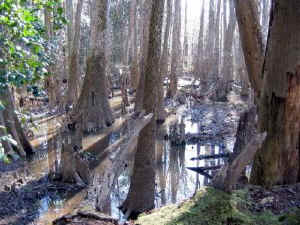
I would have to say, and many would agree that the loblolly
pines (Pinus
taeda) in the park are the showcase species. I am convinced that
this
species, by volume, will be the largest member of the Pinus
genus in eastern
North America. Eastern white pine will have to have a major
surprise
somewhere to compete with the huge loblollies. ENTS has already
climbed and
measured one loblolly to ~1500 cubic feet, tied for the moment
with eastern
hemlock as the largest eastern evergreen conifer. However, we
know of three
eastern hemlocks that will exceed 1500 ft3 but they have not
been climbed
and measured yet. ENTS does not yet know of an eastern white
pine to reach
1200ft3, let alone 1500ft3. We have a few trees in mind, but
they have not
been aerially measured yet, but field observations indicate that
1500ft3
will be nearly impossible to obtain with current trees. Future
trips should
include more loblolly documentation as they are fewer in number
every year
and not regenerating. They are extremely impressive trees
considering how
well they can withstand hurricanes with full, unobstructed wind
loading in
saturated soils. Pinaceae Rules!
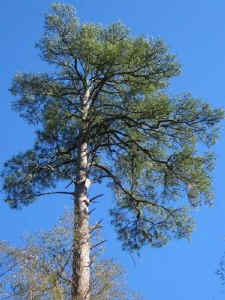
Maximum dimensions for loblolly pine we have found in the
Congaree are 173'
tall and 16' in girth. We do not know of a tree with either
dimension
currently alive, with 168.7' tall and 15'7" girth the
current maximums
known. We have not measured all the pines by any means but the
chances of
finding larger-girthed trees are slim- a taller tree likely but
not much
taller. Without a doubt, they are the tallest species in the
park. A study
done in the mid-nineties reported trees in this height range but
the
measurements were in extreme error. One tree listed at 168' 10
years ago is
"only" 143' now. Another listed at 162' is actually
134'.
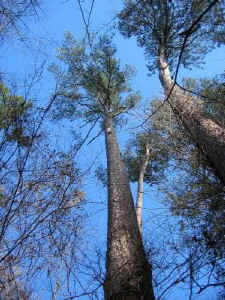
The second tallest tree is of all things an oak! The
incomparable cherrybark
oak (Quercus pagoda) is one of the fastest growing, widest and
tallest trees
in the east. Jess and Ed confirmed one to 160.2' tall, making it
the 6th
hardwood species to join the "160 Club", joining
tuliptree, sycamore, pignut
hickory, black locust, and white ash. If 160' tall wasn't
enough, we found
one that measured 154' across! Folks, these trees are immense! I
am baffled
by the sheer strength of the wood to hold a canopy so high and
so wide
through so many hurricanes. I did notice that for an oak, they
are very
slender and wispy, and have few large branches and an open
crown. I would
think that such crown architecture would reduce wind loading and
stress on
the main trunk, acting in a way like a fishing rod that
dissipates the
energy over a long section of stem. Composed as such, they have
very little
volume for their immense size, but 2500 ft3 is not out of the
question.
Girths over 22' have been measured by ENTS and girths of over
24' are known
from the park. However, all exhibit extreme root flare and do
not maintain a
trunk of such dimension for any distance. Cherrybark has been
recorded to
over 170' in the park, but the measurements were also in error
(that was the
160.2' tree ten years ago). One tree, with the 154' spread, was
listed as
156' tall but is actually 134'. (Jess, I know I probably botched
the 1995
figures so correct me as needed ;)
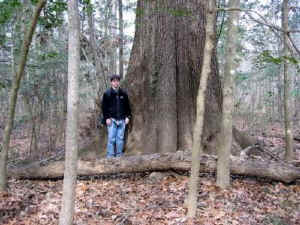
While Jess and Ed where measuring the tall oak, I was busy
trying to
remeasure a sweetgum (Liquidamber styraciflua) I had measured to
157.1' tall
several years ago. I was only able to get 150' by shooting
straight up from
underneath, and 149.8' from a distance away. I am not sure what
the
difference is (crown breakage?) but I am hereby discarding the
higher
figure. Heights of over 160' have been reported from the park
but after
numerous searches and measuring hundreds of old and young trees,
ENTS can
only attest to a few sweetgums over 150'. As a species they
certainly have
the capability to regularly grow above 150', but their
relatively brittle
and decay-prone wood does not hold up to storm damage like the
oaks.
Re-sprouting after breakage is vigorous and dense, and some of
the trees
measured over 150' during this trip were severely damaged. I
have little
doubt they can and will reach 160', but it will likely be a tree
100 years
old or less in a dense, second-growth forest on a good site.
130-135' tall
trees are very common, but trees over 140' infrequent. Only one
sweetgum
over 150' tall is known outside of the Congaree and it, too,
grows in SC
near Tamassee Knob. Trees in the Smokies have already surpassed
143' in 70
years.
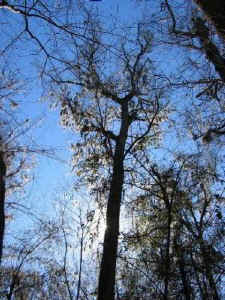
Probably the finest tree encountered was the absolutely
gorgeous, massive,
and tall swamp chestnut oak (Quercus michauxii). Ed and I both
went nuts
over them, and measured virtually every one we saw. Trees over
130' were
commonplace, and we confirmed one to 140.3' tall. The remnant
acorn caps
were so huge, 1.25" diameter, that I would consider wearing
a hardhat during
nut-fall. Not an acorn was to be found, and the ground beneath
every tree
looked to be tilled by feral hogs. We no doubt traversed dozen's
of acres of
nothing but tilled soil with almost no ground vegetation in
sight. So
extensive was the hog rooting that green plants on the forest
floor stood
out as a surprise. Such areas were a relief after walking on
uprooted,
irregular and muddy soil for miles. As anticipated, we
encountered several
hogs on our bushwhacks.
I have lots of photos from the trip which I will send to Ed
Frank to post.
(Photo
Gallery)
Species Girth Height
Significance
Loblolly pine 15'6" 143.5'
Listed as 168' in 1995
12'4" 153.3'
14'11" 156.5'
Height to large break, may have been near 170'!
10'7" 160.5'
10'8" 160.9
11'11" 165.5'
15'7" 167.8'
Current National Champion, the "Riddle Pine"
9'5" 168.7'
Tallest known living tree.
Swamp chestnut oak 16'9" 132.1 100'
average crown spread
13'1" 132'
17'6" 140.3'
108' average crown spread (114' max). SC State Champion?
Cherrybark oak 19'10" 160.2'
ENTS height record
~21' 134'
Average crown spread of 145' @ 105 feet above the ground.
Water oak 10'6" 134'
Eastern height record?
Willow oak 12'4" 139.7'
Eastern height record?
Shumard oak 13'5" 137.9'
~15' 140'
Eastern height record?
"Mule" oak 11'8" ~130'
Likely Q. phellos x pagoda hybrid.
Winged elm 6'2" 131.1'
Eastern height record?
Bitternut hickory 9'6" 137.3'
Average spread 80'. 271 points= SC State Champion?
Sugarberry 6'11.5"
111.6'
Another was 113'+
Red mulberry 4'9" 59.7'
4'0" 65.6' State
height record
Paw paw 18.5" 43.1'
17" 46.1'
16" 53.3'
Red bay 3'7" 68.3'
Eastern height record?
Musclewood 3'3" 68'
3'4" 69'
3'1" 77.3'
Eastern height record!
Blackgum 7'5" 121.4'
Near height record!
Water tupelo 8'9" 116.1'
12'7" 118.8'
10'2" 125.9'
Eastern height record?
Swamp tupelo ~125'
Eastern height record?
Sweetgum 7'6" 139.6'
13'6" 145.8'
10'2" 149'
12'10" 150.3'
11'7" 152.4'
New ENTS height record!
Red maple 6'2" 122.3'
Baldcypress 9'10" 132'
15'6" 139.3'
American holly 4'10" 89.8'
6'7" 93.8'
Eastern height record?
The 10 tallest trees:
Loblolly Pine
168.7'
Cherrybark oak 160.2'
Sweetgum
152.4'
Sycamore
144.0'
Baldcypress
141.0' Previous trip by
BVP
Swamp chestnut oak 140.3'
Shumard oak
140.0'
Willow oak
139.7'
Bitternut
137.3'
American elm
135.0' Previous trip by
Riddle
Congaree National Park Rucker index= 145.86
The Rucker Index may climb slightly, but I think we have it
pretty much
maxed out. Without the super canopy loblolly pine, an index of
142.4 would
result, which is pretty darn good for a flat site in
"hurricane alley".
Will Blozan, Ed Coyle, and Jess Riddle
|